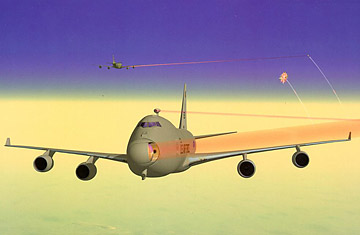
A computer-generated image of the antimissile laser beam in action
A specially outfitted 747 used an onboard laser beam last week to shoot down a missile for the first time. It was, perhaps just as significantly, a flying military-industrial complex all by itself. Boeing (the nation's third-biggest defense contractor) built the plane that carried the laser (built by Northrop Grumman, the nation's second biggest defense contractor) that was aimed by Lockheed Martin (the nation's biggest defense contractor). It took the three companies 14 years (eight more than expected) and $4 billion ($3 billion more than anticipated) to finally shoot down the fake enemy missile over the Pacific. The firms pocketed about $75 billion from the Pentagon last year.
The shootdown itself was impressive. A basketball-size beam traveling 670 million m.p.h. (1,078 km/h) — the speed of light — blazed from the 747's nose. The beam focused on the missile and — like a kid torturing an ant with a magnifying glass — incinerated it. It fit the criterion enunciated in 2008 by Boeing's laser chief Mike Rinn: "There's nothing like flaming wreckage" to prove such lasers are not science fiction.
While that may be true, Defense Secretary Robert Gates killed plans last year to buy a fleet of lasered 747s. However, Gates has continued R&D, and that gives missile-defense backers a flickering flame of hope. There's no doubt the companies involved — and their supporters in Congress — will use the shootdown to try to resurrect the program. After all, the heart of the program isn't a lumbering fleet of airliners but the chemical-oxygen-iodine lasers within.
And so, after shooting down the missile, the three companies' p.r. shops deployed superlatives in close formation. Lockheed boasted that the test "validates the effectiveness of this revolutionary technology." Northrop declared the laser's "unprecedented mobility, precision and lethality" will lead to "game-changing technology for our military forces." Boeing said "the capability to precisely project force, in a measured way, at the speed of light, will save lives."
Also jobs. "Today's successful test should be a wake-up call to the Administration, and I'm again calling on the President to restore full funding to the program immediately," GOP Congressman Todd Tiahrt of Kansas said within hours of the test. Many of his constituents work on the laser plane at Boeing's Wichita plant, where Tiahrt too was employed for 14 years. "We know the threat from rogue nations such as Iran and North Korea is very real, and we should be doing everything possible to counter this threat."
It's just that cramming a powerful laser into an airplane doesn't work very well. The goal is to destroy enemy missiles above the clouds — at more than 40,000 feet — within two minutes of launch, from within 250 miles (400 km). That would require deploying several such planes near enemy launchpads and having at least one fly continuously until the missiles are fired or the crisis eases.
Gates wasn't impressed by the scheme. "After more than a decade of research and development, we have yet to achieve a laser with enough power to knock down a missile ... more than 50 miles from the launchpad — thus requiring these huge planes to loiter deep in enemy airspace to have a feasible shot at a direct hit," he noted after he axed the program. "Moreover, the 10 to 20 aircraft needed would cost about $1.5 billion each, plus tens of millions of dollars annually — each — for maintenance and operations," he added. "The program and operating concept were fatally flawed."
But not according to the antimissileers. Flying lasers are the dream of Star Wars boosters, theoretically combining the speed of light with multiple shots from a single platform. Such lasers play into America's can-do hubris, compounded by the frisson of excitement generated by theoretical invulnerability they provide. "The airborne laser is initially proven and should continue to be developed, tested and even deployed if necessary," Riki Ellison, a former NFL linebacker who now heads the Missile Defense Advocacy Alliance, said shortly after the shootdown. "The ability of our military to use the airborne laser ... to engage and destroy multiple Iranian missiles in seconds over Iran could be a critical asset if in the future a situation arose between Iran and the United States."
Such blind faith, even in the face of the evidence that led Gates to kill the program, highlights the difficulty of developing smart missile defenses. The challenge is especially difficult when the program generates an almost religious fervor among its advocates, especially given its tie to Ronald Reagan. In 1983, he launched the Strategic Defense Initiative, which ultimately gave birth to the airborne laser, expressing his desire to render nuclear weapons "impotent and obsolete." The nuke-laden enemy Reagan was focused on — the Soviet Union — wound up being impotent and obsolete. Nuclear weapons, alas, are still alive and well.
